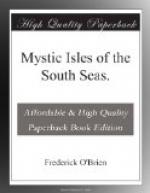Choti and T’yonni and I spent an hour at my house before they walked home to bed, and Choti read as a soporific, with a few bottles of Munich beer, the “Sermon to the Fishes” of St. Antonius. As he read, we heard the joyous stridence of an accordion in a hula harmony. The upaupahura was beginning in the grove where Uritaata lived. The austere St. Antonius had lectured long to the eels on the folly of wiggling, to the pikes on the immorality of stealing, and to the crabs and turtles on the danger of sloth. But:
“The sermon now ended,
Each turned and descended;
The pikes went on stealing,
The eels went on eeling;
Much edified were they,
But preferred the old way.
“The crabs are back-sliders,
The stock-fish thick-siders,
The carps are sharp-set,
All the sermon forget;
Much delighted were they,
But preferred the old way.”
Chapter XXV
I meet a sorcerer—Power over fire—The mystery of the fiery furnace—The scene in the forest—Walking over the white hot stones—Origin of the rite.
Walking to the neighboring district of Pueu with Raiere to see the beauties of the shore, we met a cart coming toward Tautira, and one of the two natives in it attracted my interest. He was very tall and broad and proud of carriage, old, but still unbroken in form or feature, and with a look of unconformity that marked him for a rebel. Against what? I wondered. Walt Whitman had that look, and so had Lincoln; and Thomas Paine, who more than any Englishman aided the American Revolution. Mysticism was in this man’s eyes, which did not gaze at the things about him, but were blinds to a secret soul.
Raiere exchanged a few words with the driver of the cart, and as they continued on toward Tautira, he said to me in a very serious voice:
“He is a tahua, a sorcerer, who will enact the Umuti, the walking over the fiery oven. He is from Raiatea and very noted. Ten years ago, Papa Ita of Raiatea was here, but there has been no Umuti since.”
“What brings him here now?” I asked. “Who pays him?”
Raiere answered quickly:
“Aue! he does not ask for money, but he must live, and we all will give a little. It is good to see the Umuti again.”
“But, Raiere, my friend,” I protested, “you are a Christian, and only a day ago ate the breadfruit at the communion service. Fire-walking is etene; it is a heathen rite.”
“Aita!” replied the youth. “No, it is in the Bible, and was taught by Te Atua, the great God. The three boys in Babulonia were saved from death by Atua teaching them the way of the Umuti.”
“Where will the Umuti be?” I inquired. “I must see it.”
“By the old tii up the Aataroa valley, on Saturday night.”
That was five days off, and it could not come soon enough for me. I was eager for this strangest, most inexplicable survival of ancient magic, the apparent only failure of the natural law that fire will burn human flesh. I had seen it in Hawaii and in other countries, and had not reached any satisfying explanation of its seeming reversal of all other experience. I knew that fire-walking as a part of the racial or national worship of a god of fire, had existed and persisted in many far separated parts of the world.




